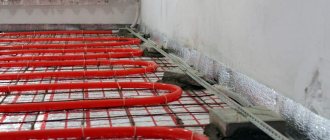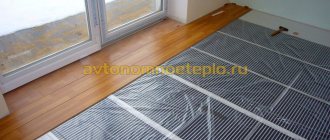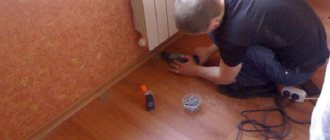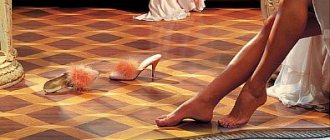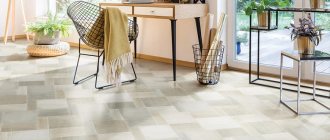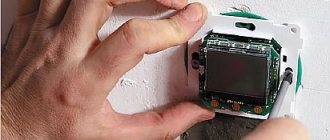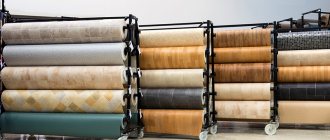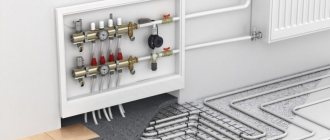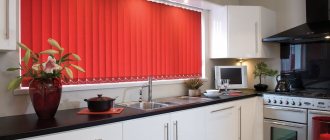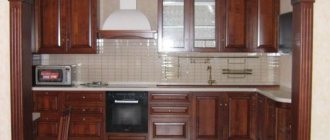Electric underfloor heating is a convenient and effective option for heating your home. At the same time, it has a lot of specific features that require taking into account all the working properties of the structures and materials used. Particular attention should be paid to the quality of the flooring.
If you plan to lay linoleum, you need to analyze its operating conditions and select only appropriate materials. There must be appropriate markings; the structure and composition of linoleum are selected based on the mode and characteristics of the heating element. Let's take a closer look at this issue.
Operating principle of infrared floor
The combination of linoleum made of flammable polymers and electric heated floors at first glance seems unacceptable.
However, the risk of short circuit and fire in the infrared film heating system is reduced by manufacturers to almost zero. You just need to follow the instructions when assembling it, doing everything according to the rules. At the same time, today the linoleum coating itself can be found with fireproof characteristics “G1” + “B1”. The operation of an infrared floor is based on the emission of infrared waves by carbon heating elements. These rays first heat the surfaces of various objects in the room. And from the furniture and walls, heat spreads throughout the room, creating comfortable conditions in it.
Necessary layers for laying heated floors
Among the advantages of film heated floors are:
- instant heat transfer after switching on;
- installation using dry technology without pouring a concrete screed;
- service life of 50 years;
- silent operation;
- ease of installation work;
- safety of IR radiation for humans.
Electricity is converted into infrared rays by thermal film with an efficiency of 90–100%. And unlike a water heated floor, the film analogue cannot cause a flood, because there is no water in it.
It is allowed to lay linoleum, laminate, tiles or carpet on top of it. Moreover, installing such underfloor heating in a room of up to 20 m2 on a prepared base requires only a couple of hours.
The disadvantages of this heating system are the following:
- high price of IR film;
- high electricity bills;
- dependence of heating on the presence of voltage in the electrical network.
With a small active area of a heating floor powered by electricity, its power consumption is within the range of 1–3 kW. A regular outlet will be enough for it to work. But with higher consumption for thermal film, you will have to lay an additional cable from the electrical panel and install an appropriate RCD there, which costs money.
Warm floor design
And whether the required kilowatts are available is a big question. Apartments and private houses are designed for a very specific energy consumption, which cannot be exceeded. Before purchasing infrared linoleum floors, you must first clarify the very possibility of connecting them to an existing network. If there is no capacity, then you will have to look for another option for arranging heating.
Choosing linoleum
Most users choose linoleum based on appearance. It’s hard to argue with this, since the appearance of the coating is very important; it largely determines the style and overall quality of the room’s design.
However, to install it on a warm floor, you need to choose the right type of linoleum. There are three categories of material:
domestic
semi-commercial
commercial
All types of linoleum are divided into two groups:
- homogeneous material . This is a single-layer linoleum, representing a homogeneous fabric;
- heterogeneous linoleum. It is a multilayer material consisting of a base, a substrate, a base layer, and an outer coating.
Homogeneous linoleum is thinner than heterogeneous. In addition, it has high thermal conductivity, which is of great importance for working with heated floors.
Experts recommend choosing homogeneous linoleum, since multilayer materials are too dependent on temperature conditions and can begin to delaminate.
In addition, there are varieties made from natural materials or polymers (PVC). Natural linoleum is called marmoleum; only original components of natural origin are involved in its production:
- jute base;
- resin;
- wood flour;
- limestone;
- linseed oil.
Artificial linoleum is made from PVC with the addition of plasticizers and various compensators (for example, to protect against thermal expansion or changes in the linear dimensions of the canvas).
There are other varieties:
alkyd or glyphthalic linoleum
nitrocellulose, or colloxin. Thin material without base. It has high performance qualities, but is highly flammable;
rubber linoleum (Relin). Double layer material. Does not tolerate heat well and is used mainly in public or office spaces.
Not all types of linoleum are suitable for laying on a warm floor. Experts recommend choosing homogeneous (baseless) linoleum with a thickness of 2-3 mm. At the same time, marmoleum is considered one of the best options, although it has a jute base.
In addition, it is necessary to choose specialized brands of linoleum. They must have a base with antistatic treatment. In addition, the material must maintain working properties when heated and not dry out, crack or change color. Linoleum, designed to work in conjunction with electric types of heated floors, has a special marking on the reverse side - a heated floor icon (snake with arrows). If there is no such designation, the buyer risks soon having significant problems with the floor covering.
Which linoleum to choose
So, you have decided on the type of design. However, before you start preparing heated floors for linoleum, you should select the appropriate material. We must never forget that this is synthetic material, which at high temperatures begins to release toxic substances. Depending on the structure, heated linoleum is:
- natural;
- alkyd;
- polyvinyl chloride;
- rubber (relin);
- nitrocellulose.
If you are very interested in the environmental friendliness of the coating when asking whether it is possible to make a heated floor under linoleum, we recommend that you pay attention to marmoleum - a natural material with high strength, fire resistance, antistatic properties and many other positive properties. This roll coating can last for decades, maintaining its original brightness and attractive appearance. When you are planning to install a heated floor under linoleum, there is no better solution. Marmoleum is suitable for both pipes and cables with film. Its only downside is the price. Synthetics are much cheaper.
If you are installing heated floors under linoleum, Relin is definitely not suitable. Rubber reacts poorly to thermal influences. For water structures, polyvinyl chloride materials are recommended; for film, they are also recommended, plus some modifications of alkyd rolls. Be sure to pay attention to such a characteristic as the degree of thermal conductivity. Installing a heated floor under linoleum will be ineffective if the coating retains the energy coming from the heating elements. For example, materials based on foamed PVC are not suitable for such structures.
When laying heated floors under linoleum on concrete or wood flooring, remember that the maximum heating temperature is 180 W/m². If you plan to use the equipment as the main heating, this power may not be enough for complete comfort. Be sure to check these points with the seller, otherwise the coating will quickly deform and begin to emit unpleasant odors.
Types of linoleum
Manufacturers produce several types of this material:
- On a polyvinyl chloride basis . It is considered one of the most affordable options, but it has a limitation regarding the maximum heating temperature, at which it cannot exceed plus 28°C. Warm floors under linoleum should be installed with caution, maintaining constant control over the operating mode.
- Glypthal . The surface of such linoleum is coated with heavy-duty glyphthalic varnish. The consumer characteristics of this coating meet modern requirements. It is the best choice if you are deciding how to make a warm floor under linoleum. It has a big drawback - high cost.
- Rubber . This type of linoleum is the cheapest. It is rarely installed in residential premises due to unsatisfactory quality indicators. When installing heated floors in industrial buildings, rubber linoleum can be used.
- Single layer . This flooring material is inexpensive and at the same time fragile, it needs to be changed often. This linoleum is laid in contaminated areas. Installation is carried out with an overlap, welding it using special equipment.
- Insulated linoleums . The floor covering made with their use is laid in a thick layer; it has a low degree of thermal conductivity. Experts do not recommend using insulated linoleum for heated floors, as this leads to a decrease in the efficiency of the heating system.
We recommend: Warm water floor
When purchasing this material, you need to pay attention to the presence/absence of a fabric bedding layer. If it is present, then the degree of thermal conductivity is significantly reduced and therefore laying a heated floor under linoleum is undesirable.
Types of linoleum
In order for linoleum to last a long time, you need to figure out which type is suitable for laying on a floor with electric or water heating. Among the most common on the market you can find 4 types of linoleum:
- Rubber is a two-layer material consisting of rubber, bitumen and synthetic rubber. This option is not suitable for residential premises and, especially, for heated floors, as it deforms when heated.
- Colloxylin is a thin single-layer material with good moisture resistance. The disadvantages are that they are highly flammable and not suitable for electric floors.
- Alkyd is a material with a fabric base and excellent thermal insulation properties. But it is sensitive to heat, as a result of which it loses its original shape.
- Vinyl (PVC) is the most popular type of roll covering due to its affordability. Has a fabric backing that can trap heat and slightly reduce the efficiency of electric heating elements.
- Natural (marmoleum) is the most environmentally friendly. It is fireproof, durable, and resistant to deformation. The downside is that it is more expensive than other types.
Preparing the base
Installing a heated floor under linoleum begins with preparing the base. The easiest way is to fill in a new screed, and then proceed with the installation of the structure according to one of the classic schemes. However, when you place heated electric floors under linoleum on a wooden floor, the additional layer of concrete can have a negative impact on the stability of the entire structure. In such cases, it is necessary to use different restoration methods.
The main requirements for the base on which the rolled heated floor under linoleum is placed: evenness, cleanliness and the absence of noticeable defects. First of all, all cracks and gaps have to be eliminated. Next, the surface is treated with antiseptics and waited until completely dry. When you install an electric heated floor under linoleum on a concrete floor that you have just made, the surface will be flat by default (subject to basic construction technology). In the case of an old base, leveling will most likely be required. When installing water equipment, the requirements for this parameter are not so strict. When installing a film heated floor under linoleum, do-it-yourself installation requires the presence of an almost ideal surface. If it is unrealistic to eliminate unevenness and differences by resorting to sanding, you can lay plywood. It is important that the edges of the boards fit very tightly to each other.
Thermal insulation
Before installing a heated floor under linoleum, the base should be well insulated. If this is not done, some of the energy will flow down. If you don’t want to waste heat so inefficiently, you’ll have to spend money on purchasing insulating material. In the role of insulation, which makes floor heating under linoleum as effective as possible, you can use:
- extruded polystyrene foam;
- polypropylene plates;
- metallized lavsan film;
- cork backing.
To properly lay a heated floor under linoleum, the insulating material must be placed with the reflective surface facing up. The strips/plates are secured with construction tape or staples from a stapler. The elements should fit together as tightly as possible. For reliability, the seams should also be taped.
Surface preparation
Screeding and cleaning the floor surface
Regardless of what type of heated floor is chosen, for its installation it is necessary to prepare a reliable base that meets safety requirements.
The concrete base is processed in the following sequence:
- Removing old finishes and remaining construction debris. Dismantling of communications.
- Checking the surface condition. If there are cracks and holes, they need to be sealed. Protruding fragments are ground down or cut down. If the slab sag significantly, it should be leveled with a light gypsum mortar.
Thermal insulation for heated floors - Treat the base with a deep penetration primer. To achieve the best effect, you need to do this twice.
- Applying a waterproofing layer. At the choice of the master, film or coating materials are used.
- Laying insulation. Depending on the characteristics of the room, polystyrene foam, penofol or penoplex are used.
- Covering the material with insulating material (roofing felt, polyethylene).
Finally, a rigid base is manufactured. Fiber cement boards with locks are used or screed is poured.
Installation of heated floors in a wooden house
A wooden floor is prepared using the following method:
- Removing the finish. If you plan to reuse it, this must be done carefully and carefully.
- Inspection of wood for rot, fungus and mechanical damage. Carrying out repairs to the required extent.
- Treating the floor with an antiseptic and fire retardant. Application of liquid impregnation.
- Arrangement of waterproofing using strips of waterproof material.
- Laying and fastening the membrane sheet with staples to remove moisture.
- Placement of insulation. For wood, it is better to use perforated penofol on aluminum foil.
Work should be carried out on well-dried wood. Otherwise, when drying, it will lead, which will cause deformation and destruction of the laid materials.
Necessary materials for laying heated floors under linoleum
When installing heated floors under linoleum on a wooden floor, you should ensure that you have the following equipment and tools:
- heating element (carbon film or other type);
- required number of contact clamps;
- thermostats and temperature sensors (their number depends on the number of connected rooms);
- electrical cable;
- double-sided tape and standard mounting tape;
- thermal insulation (isolon, polystyrene foam or other material with low thermal conductivity);
- Fiberboard and finishing material (in this case, linoleum).
Note! It is necessary to use a soft type of insulation that can be easily changed using improvised means, such as a mounting knife. This is necessary to cut out space for wiring and a temperature sensor.
Advantages and disadvantages of linoleum
One of the advantages of linoleum is its wide range of colors.
The coating has a long history of use. Manufacturers are constantly working to improve its composition and appearance.
Advantages of the material:
- Affordable price. This is the first thing that property owners with a limited renovation budget pay attention to. The price per square meter of coating is several times lower than ceramic tiles, solid wood, laminate and parquet.
- Variety in composition and structure. The buyer can purchase cold-type products without a backing and warm coverings with a felt or foam polymer lining.
- Wide selection of colors and designs. Depending on the purpose of the room, rolls with a plain or colored surface, with a smooth or embossed pattern are purchased for finishing it.
- Flexibility. Thanks to this quality, linoleum can be used for sagging slabs and curved areas.
- Easy to install. The material is easily cut to the desired size using available tools. You can lay the workpiece on the floor in a matter of hours.
- Ease of maintenance. The surface can be cleaned with household detergents without much effort.
- Durability. Linoleum is resistant to dampness, mold and mildew do not grow on it, insects and rodents avoid it.
Before laying linoleum, floor preparation is required, otherwise all defects will appear on the coating.
Disadvantages of the coating:
- The need for preliminary preparation of the base. Strips can only be laid on flat surfaces without cracks, noticeable depressions or protrusions. If they are not repaired, defects will appear on the coating.
- Insufficient strength. The material is easily cut and pierced with sharp objects. Moving furniture on it is contraindicated. This feature is especially acute in the kitchen, where linoleum quickly becomes unusable from contact with dishes and cutlery.
- Destruction under the influence of ultraviolet radiation. If you lay the covering in the loggia, after a year it will fade and lose elasticity.
- Size instability. When the temperature rises, the coating expands, and when it decreases, it shrinks. To prevent deformation, linoleum should be placed on glue.
Linoleum continues to be popular, including as a finishing for warm bases. To make the right choice, you should familiarize yourself with the types and features of heating systems and the rules for their installation.
Types of materials for floor waterproofing
Paint insulation
Such compositions can be used for waterproofing when insulating wooden and concrete floors. Silicone, acrylic, rubber, polymer based mastics are applied to the surface using a brush or roller. The layer of such insulation is 3-6 millimeters.
Coating insulation
It is very common and is used to protect internal and external surfaces from moisture. When applied, it forms a monolithic layer of high density. It is a bitumen-polymer base with the addition of solvents and additives that increase plasticity. Very reliably protects the treated subfloor. Coating insulation used for floor insulation will significantly increase the efficiency of insulation.
Pasted waterproofing
It is produced in the form of rolls and is a durable fiberglass base coated with a bitumen-binding composition with the addition of polymers. Very easy to install. On one side there is a self-adhesive base. The installation of such waterproofing for insulation can be done with your own hands without the use of professional equipment and tools. Affordability complements the advantages of adhesive insulation.
What is linoleum
Linoleum is a group of artificial floor coverings. The name itself indicates the presence of natural components in the material (the name of the material is derived from the abbreviation of two Latin words linum and oleum, linen and oil). Today, using improved ancient technologies, floor coverings are also made from natural ingredients. It's called marmoleum. However, most modern linoleum is made from polymers.
Externally, linoleum is a continuous sheet of elastic polymer material. It is laid on the floor and fixed with adhesives, or left to lie without fastening. The canvas has sufficient weight and rigidity not to react to walking or moving objects - linoleum can only be crushed by applying significant mechanical loads.
A flat horizontal surface is required for installation. There should be no dents or dents on the base. Any sagging of the canvas sooner or later becomes an area of damage - it is enough to step on the defective area several times for the linoleum to begin to stretch. If the pothole is large enough, the canvas will begin to tear, which is unacceptable.
Temperature limits for a wooden base under heated floors
Any coating or base for electric heating has its own thermal limitations in operation. So, the optimal temperature for a wooden floor is 25–26 degrees. The maximum permissible temperature is 27 °C. This indicator is valid for the floor surface. But you should understand that the sensor is not mounted on the floor, but directly in its structure. Therefore, on the thermostat you should expect the parameters listed in the following table:
From the above data it is clear that for soft species (pine) higher temperatures are allowed, while when using hard types of wood (oak, hornbeam) one should strive for a slightly lower regime.
Important! At an average room temperature close to 20 degrees, a specific power of 80–100 W/m will be sufficient for the floor. In this case, the temperature on the surface of the coating will be approximately 26 °C.
When using infrared heating in a room with poorly organized insulation, the issue of achieving optimal temperature conditions is not extremely pressing. In this case, it is possible to operate heating devices with a specific power of at least 80 W/m2.
Compliance with thermal conditions
To select a high-quality floor covering, no special knowledge is required, because in the instructions the manufacturer indicates the possibility of using this material in the construction of heated floors. This information can be found near the marking; the permissible heating level is also reflected there; it is 27 degrees.
For your information! If the temperature is exceeded, the floor product will be damaged.
PVC linoleum can withstand +30, but there is no guarantee that the material will not be damaged, and the release of harmful substances is also possible.
To monitor compliance with the temperature regime, you will need a high-quality thermostat, ideally digital. Then, the temperature level will be maintained automatically.
Drawing up an installation diagram
Film heated floors under linoleum are not laid over the entire area of the room, but only in its open areas. You cannot place heating film under furniture and household appliances. It can get damaged and tear there. Plus, in such areas, local overheating of the coating and elements of the infrared system itself will occur. To avoid making mistakes, you need to draw up a floor plan in advance indicating all such places.
IR thermal underfloor heating film is placed:
- exclusively in the middle of the room where people will walk;
- with a distance from the walls of 5–10 cm;
- at a distance of 30–50 cm from radiators, fireplaces and stoves with ovens;
- stripes not overlapping and with a cut only across in the places indicated on the film.
We recommend: Do-it-yourself heating (heating) of a greenhouse: 8 best projects
All these installation nuances must be taken into account when drawing up the plan. Also on it you should immediately determine the installation location of the thermostat (temperature regulator) and temperature sensor for the infrared heated floor. It is not recommended to install the underfloor heating system in question without these two elements.
Types of IR floors
Nuances of design and calculations
Let us analyze the calculation procedure using a specific example of the installation of a Caleo brand film system produced for laying linoleum. Let us take into account that this type of coating is used mainly in the arrangement of bathrooms, corridors, kitchens of multi-storey and low-rise buildings, stairwells of private buildings reserved for winter gardens and other similar premises.
Standard arrangement of layers in a pie
A heated floor linoleum floor will include five required layers, these are:
- Thermal reflective substrate. It is recommended to use materials such as Izolon or Infralex. It is allowed to use thermal insulation with a polypropylene or lavsan metallized outer shell. It is prohibited to lay materials with a base made of aluminum foil under the IR floor.
- Infrared film floor. The system includes longitudinal panels with a carbon striped coating, at least one temperature sensor and a thermostat. The panels of the film system are connected to the power source in parallel using the terminals and wires provided in the factory kit.
- Polyethylene. Placed on top of the heating system after it has been assembled and tested. Plays the role of waterproofing infrared electric floors. Maximum thickness 2 mm.
- Protective hard layer. Made from plywood, hardboard or similar material. Required for installing heated floors with a flexible finish.
- Linoleum. Only brands that are compatible with electric floor heating are suitable.
When designing, it is necessary to take into account that the direct infrared-type film heated floor is not placed under furniture without legs or with low legs. It is unwise to heat objects that do not require heat supply, but are capable of consuming an impressive amount of it.
But an insulating substrate and a rigid layer are placed over all areas of the room in order to maintain a single height level of the floor. Waterproofing, despite its insignificant thickness, is laid in the same way over the entire area to prevent water from penetrating into the electrical system during wet cleaning.
Drawing up a laying diagram
For competent design, it is necessary to draw up a plan or an elementary diagram with scaled real dimensions. A hand-written project will help you correctly calculate the footage of thermal film and related consumables.
The panels of the heating system, waterproofing and heat-reflecting substrate are attached to each other with single- or double-sided tape.
In addition to these nuances, design must take into account the following:
- IR thermal film can only be cut along the lines designated by the manufacturer. Cutting at an angle and forming shaped panels is not allowed.
- Laying is done in parallel strips. It is not allowed to overlap one panel with another.
- A gap of at least 3 cm should be left between low-standing furniture and the film floor. An equal gap should be left between the edge of the panels and the walls: it will ensure heat removal in case of overheating.
- It is recommended to lay the cut strips of thermal film with a side overlap so that there is a gap of at least 1 cm between the copper bars of adjacent panels. This arrangement will ensure uniform heating of the floor.
- The heating system panels should have the maximum possible length in order to minimize the number of connection points.
- The connection points must be located on the side of the wall on which the thermostat will be installed. Thanks to this, the footage of wires required for connection will be significantly reduced.
- The laying of wires must be thought out so that the main array of them is located under the baseboard.
It should be remembered that when cutting the film floor into short sections up to 1 m in length, additional insulation and the use of additional terminal clamps will be required. Those. You will have to purchase an installation kit in addition to what is included in the package.
You need to decide in advance on the type of thermostat, which can be built-in or overhead. To install the built-in type, you will need a corrugated polymer pipe, used when laying in a groove; for open wiring, you will need a plastic cable channel. For large areas or floors in adjacent rooms, additional temperature sensors may be required.
Additional electrical and insulation
If you plan to connect several sets of film flooring to one thermostat, then the power consumption is determined by adding the powers of all elements. The wire for connecting parts of the IR floor to the thermostat is selected in accordance with the result.
You should purchase the cable required to connect the thermostat to the power supply, because The factory kit provides a wire only for connecting the film heating to the thermostat itself. It must be selected in accordance with the maximum power required for the functionality of the system.
Do not forget that electric heated floors are installed with the obligatory inclusion of an RCD in the network with response parameters of 30 mA, acting on the wiring for 100 ms. You will need a category C circuit breaker designed to protect a 10 A current-carrying branch.
If other electrical appliances are connected to the automatic protection devices, their power should be taken into account when calculating. For film floors consuming 2 kW or more, it is recommended to arrange a separate branch with its own automatic machine.
Step-by-step guide to installing heated floors under linoleum
Step one is preparing the base. When you plan to install the floor on a concrete floor, first of all, the surface should be leveled. To do this, it is advisable to lay the screed using a cement-sand mortar, avoiding the presence of protrusions larger than 3 millimeters.
After it has completely dried, a layer of waterproofing is laid, for which regular polyethylene or modified bitumen mastics are used. Sheets of plywood or OSB are mounted on top. They are attached to the concrete base with dowels, arranged in a checkerboard pattern. If there is no need to level the base, you can lay a heated floor under linoleum without a screed.
Step two is to take measurements and draw up a diagram for installing the thermal film. At the same time, the features of the layout of the room, the location of sockets or boxes intended for wiring electrical cables are taken into account.
Before installation, be sure to pay attention to the possibilities of electrical wiring in the house or apartment. The fact is that an electric heated floor under linoleum consumes about 200 W per “square” of area. Detailed information about this can be found in the manufacturer's instructions. The load on the electrical network increases significantly and you need to be sure that the cables and protective fittings can withstand this.
When the heating power exceeds 3 kW, then it is necessary to lay a separate line. The problem may have to be solved with the help of electricians, or the wiring and protective devices must be changed, or permission must be obtained to increase the power of the electrical network.
Step three is choosing a location for the thermostat. It should be located so that the distance to the power source is minimal. The optimal place for this is near existing sockets or switches.
In order to improve insulation and reduce heat loss, a thermal insulator with reflective aluminum foil is placed on the base of the floor under the thermal film. Its thickness should be 5–6 millimeters. There are rolls of such foil available for sale that have the necessary performance properties. To fix the thermal insulator, use double-sided tape or a stapler plus staples. The joints of the strips are sealed with tape, thereby creating a sealed surface.
Step four - installation of thermal film. In this case, you should pay attention to the existing markings, since the bottom side must be positioned towards the heat-reflecting film. Heating should not be installed under low pieces of furniture, since air convection under them will be weak, and elevated temperatures will cause rapid wear and tear. In the places indicated in the diagram, the thermal film is cut according to size.
Step five - connection and isolation are performed. All work related to how to lay an infrared heated floor under linoleum is carried out in accordance with the requirements of the PUE and the recommendations of the manufacturer. The purchased kit contains a full set of connecting parts and special insulating materials that ensure long-term and safe operation of the heating system.
The places where the copper busbar was cut are treated with special bitumen insulation, which must adhere along the entire length of the conductive element. At the points where the wires are connected to the bus, contact clamps are placed, one side of which is located inside and the other outside the thermal film. Then the clamps need to be squeezed tightly with pliers.
Step six - the thermal film is fixed with tape. This must be done to eliminate the possibility of it shifting. Next, you should make sure that the clamps and film are installed correctly. When everything is good, proceed to connecting the power. To increase the service life, it is better to tin the bare ends. Thanks to this, contact will not only improve at the joints and prevent oxidative processes, but will also increase the safety of using heated film floors laid on a wooden floor.
The fact is that in the absence of sufficient contact, the clamps can overheat and melt the linoleum. In addition, electric shock, fire and burns to the feet are possible. Clamps with connected wires require insulation on both sides with a special bitumen film. In this case, the silver contacts of the thermal film must be insulated both above and below.
Step seven - connecting the thermostat. This work begins only after studying the manufacturer’s instructions. The heating temperature sensor is placed on the black strip on the thermal film and secured with insulating tape. There are cases when it is mounted above the floor and as a result it reacts to the temperature of the air masses inside the room.
Step eight - installation of sensors. Using a mounting knife, recesses are made under these devices and clamps in the thermal insulation, into which the protruding parts of the parts are hidden, and then the floor is level. Similar grooves are created for the wires so that they are in the right places. Tape is used to secure the top.
Step nine - attach the thermostat to the wall. First, take out the mounting panel, then make markings for the dowels. To drill holes, use a drill with pobedite surfacing. Next, you need to firmly fix the body so that it does not wobble.
When drilling holes in a brick wall, sometimes the drill gets into a seam and then the fastening strength in this place will be insufficient and the dowel will begin to wobble and fall out. To ensure a strong fixation, you need to insert toothpicks or matches into the hole around the perimeter, which will press the dowel tightly on all sides. The connection will be reliable after driving in the dowel-nail.
Step ten - connect the system to the power grid. According to the diagram, the wire is connected to the thermostat. If the heating power exceeds 2 kW, then you need to install a separate machine. After this, the installation of a heated floor under linoleum on a wooden floor is considered complete.
Installation of film floor pie
Let's assume that after design and calculations we have purchased a set of infrared floors with the most suitable width and the missing components of the cake in the required quantities. It remains to figure out in what sequence and how to correctly lay the infrared film floor under the finishing linoleum.
Laying the substrate and heating system
The first step is to lay a heat-reflecting substrate, the strips of which are glued together into a single sheet with tape. In large rooms with an area of more than 20 m3, it is recommended to connect the substrate with double-sided adhesive tape in order to prevent its movement relative to the subfloor. Instead of double-sided tape, fixing with a construction stapler is suitable.
Next, we proceed to the stage of constructing the film floor:
- We cut out the thermal film according to the instructions of our own project.
- We try on the “pattern” for the future installation site. If necessary, we trim, slightly change the width of the side indentation and the gap between the walls and the heating system.
- Having decided on the position of the individual panels, we proceed to assembling the heated floor.
- We lay the underfloor heating panels strictly with the copper busbar facing down.
- We isolate the exposed contacts of the panels from the edge opposite to the connection side. We simply seal the cutting areas of the silver and copper busbar with bitumen tape so that contact with the external environment of both metal strips is completely excluded.
- We install the contact clamps on the current-supplying strip of thermal film. To do this, we slightly peel off the polymer shell in order to insert one side of the clamp under it, and place its second side on top of the copper busbar.
- After checking the correct installation, firmly fix the clamp with pliers.
- In accordance with the described diagram, we equip all contacts of the film floor with clamps on the side connected to the thermostat.
- We connect the strips with wires so that phases are connected to phases and zeros to zeros. For this purpose, the package includes wires of two different colors. We remove the insulation from the connected ends of the wire and insert them two or one at a time according to the design diagram into the clamp.
- We isolate the connection points secured with pliers with two pieces of bitumen tape on both sides.
- We connect the circuit to the thermostat.
- In a convenient place, install the temperature sensor with its convex side down and connect it to the thermostat. We cover it from below with bitumen tape. The system sensor under the linoleum must be positioned so that movement on it is eliminated or is the least intense.
The infrared floor heating system has been assembled; the final work remains on arranging the circuit and laying the finishing material.
The final stages of installing an infrared floor
To ensure that individual parts of the system do not stand out under the coating and are not subject to unwanted mechanical stress, they should be “sunk” in the insulating substrate. To do this, we cut out “windows” and “trenches” in the heat-reflecting layer under all convex parts: temperature sensor, contact clamps and wire routes.
Next, we test the operation of the film floor by connecting power to it. For a control check, set the thermostat to + 30º C. We check the operation of each contact and the safety of the insulated points with an indicator screwdriver or similar device. After making sure that the infrared system is functioning normally, we cover it with polyethylene and lay down a hard protective layer.
If necessary, a hard layer assembled from plywood, gypsum fiber board, hardboard, etc. We fasten it to the rough base with self-tapping screws so that the fixation points pass through the transparent edge of the film floor. It is more convenient to work with material that has a joining chamfer along the edge.
Don't forget that the infrared system needs to “breathe”. Therefore, along the perimeter of the hard flooring there should be a gap of 1-2 cm, which, after installing the finishing coating, is covered with a plinth.
To the constructed and secured rigid base we glue double-sided construction tape, used in laying linoleum, and lay the finishing coating itself.
Heating system testing
To do this, set the heating indicator on the thermostat at 20 - 25 degrees and wait a few minutes. Check with your hand whether the mounted film heaters have warmed up. Then the power is turned off completely to see how the electrical connections heat up.
We recommend: How to make a bio-fireplace with your own hands: assembly instructions
Their temperature should be the same as that of the film. In the case when it is much higher, this means that the contacts are unreliable. They must be checked, and the cause of excessive heating must be identified and eliminated.
How to test the functionality of floor heating
Testing the system
Set the heating setting on the thermostat to 20–25°C, wait a few minutes. Check by hand whether all installed film heaters are warming up. Turn off the power completely, check the heating of the wiring connections. They must be at the same temperature as the film. If it is significantly higher, then the contacts are unreliable. It is necessary to check them, be sure to find and eliminate the cause of excessive heating.
Finish coating for heated floors
If testing is completed successfully, installation work can continue. Thermal film must have a protective coating against exposure to water. For these purposes, you can use special modern waterproofing (expensive option) or ordinary polyethylene film (recommended option). The effect will be the same, and the savings will be significant. Spread the film with an overlap of about ten centimeters, the joints must be taped. Work carefully, do not leave gaps or loose joints.
Linoleum is a flexible coating material; it cannot be placed directly on thermal film. Manufacturers recommend protecting the heating layer with sheets of plywood approximately one centimeter thick.
Lay plywood and linoleum on top of the film
The sheets are attached to the base with small nails. They must be driven in very carefully so as not to damage the conductive elements. Check the exact location of the nail before hammering it in. Nails should be driven only along the perimeter of the sheet, this makes it possible to accurately control their position. Before fixing, it is strongly recommended to dry the plywood thoroughly in a warm, ventilated area. In this way, you can prevent the appearance of cracks during the operation of the heated floor.
Expert advice on installing heated floors
A few tips from experts will help extend the life of linoleum laid on a floor with a heating system.
Compatibility of tiles and linoleum with heated floor systems
When choosing the type of heated floor, the decisive factor may be the financial issue. A water floor, although considered the most suitable for linoleum, requires significant installation costs and a high professional level of installation specialists. An electric floor is easier to install, but power calculations confirm that it is quite energy-consuming to operate.
Infrared does not require a mandatory screed, but may not withstand external pressure due to its thin design. When installing it, you will need to lay a hard layer between the coating and the heating films. For it you will have to buy a more expensive commercial or semi-commercial option or marmoleum.
For all types of heated floors, the quality of the electric thermostat is important. Overheating the coating will cause blistering and cracking. Installing a heated floor is a complex procedure; if you have no experience in such work, it is better to contact specialists.
Recommendations and possible errors
The cake made from infrared flooring and linoleum should have five layers from the rough base:
- Izolon (heat-reflecting substrate).
- Infrared thermal film.
- Polyethylene film (waterproofing).
- Flooring made of wood or gypsum fiber boards 3–5 mm thick.
- Finish linoleum covering.
Without a heat-reflecting substrate, the high energy efficiency of an infrared underfloor heating system will be seriously compromised. And without polyethylene and protective flooring, it will sooner or later fail. The plywood layer absorbs some of the thermal radiation, but it is impossible without it.
Connection diagrams
Linoleum on top of an infrared heated floor should be laid in the form of natural marmoleum or vinyl PVC. At the same time, its marking must have a special icon. And it should go without an insulating sublayer from below. Choosing an air conditioner will require a lot of thought. With the finish, everything is simpler here. The main thing is not to take the colloxylin or rubber version, which will begin to release harmful substances when heated.
Types of heating elements and features of their use
All three categories of heating systems are suitable for installing heated floors under linoleum: water, electric and infrared. The differences relate to the design of the flooring as a whole and the complexity of installation.
Let us consider in more detail the main categories of floor heating systems, united by the term “warm floor”.
Water
The design is a set of tubes through which hot water moves. Most often it is connected to the heating system. It is logical that in houses with central heating it is quite difficult to install such a system, while for a private home this is an inexpensive and practical option.
Having a gas boiler, you can install a heated floor along with the entire heating system, and no electricity will be wasted on its operation.
A special feature of a water heated floor is the presence of a sand-cement screed between the heating elements (pipes) and linoleum. There is a risk of flooding if a pipe breaks, so special attention must be paid to insulation
Electric
It consists of a heating cable enclosed between a solid, level base and a sand-cement screed. You can regulate the temperature using a thermostat.
The advantage is that the system does not depend on the operation of the heating system; it can be used autonomously. Sometimes it is the only source of heat, for example, in cool summers, when the central heating in houses is turned off.
The electrical system is less suitable than others for laying under linoleum. The reasons relate to design features and installation complexity.
The floor covering (linoleum) in combination with electrical elements must be of high quality, otherwise it will emit an unpleasant odor and deform over time
Infrared
Thanks to its easy installation, IR flooring is the optimal solution for laying under linoleum. The thin elastic film does not steal any height, but at the same time effectively heats the entire room.
Unlike the electrical system, it consumes much less electricity, although its efficiency is noticeably higher. The coating temperature is set using a thermostat, which creates additional comfort.
Considering the relatively soft and elastic finish coating, which reacts negatively to high temperatures, it is necessary to control the thermostat settings. Maximum value – +28ºС
Practical advice
To improve the operating conditions of film heated floors under linoleum, it is recommended to follow several rules.
Warm floor under linoleum
- Do not heat the material above +26°C. As a result of prolonged heating to high temperatures, linoleum can delaminate, change its original color in places of greatest heating, soften and significantly reduce the factory strength characteristics. Increased heating increases the amount of chemical compounds released into the air.
- When laying linoleum, do not use mastics to fix it. In addition to the fact that all mastics become additional sources of release of harmful compounds, during uneven heating they can form swelling on the surface. Removing such defects later is very difficult, and in many cases impossible. Linoleum is simply spread over the floor surface. If there are concerns about movement, then you can fix the covering in several places with a stapler; staples are driven in in inconspicuous places; the best option is under the floor skirting boards.
- Do not allow thermal film to overlap each other. If the configuration of the room is very complex, then it is better to leave a small section of the floor unheated.
- The temperature in the room when laying linoleum should be at least +18°C, otherwise difficult to remove wrinkles may form. But you cannot spread it on a hot floor; after testing, it must cool to room temperature.
- It is not recommended to use this type of floor as the main heating system. The fact is that you can heat rooms to comfortable temperatures by heating the floor to t° ≥ +28°C, but this should not be allowed when using linoleum.
Adjust the operating modes only after carefully reading the instructions. During the first few days of using a heated floor, it is advisable to check the reliability of operation more often. To be sure, it is recommended to check the floor temperature with an accurate household thermometer. If significant differences in indicators are found, then it is necessary to make adjustments during the installation of thermal control.
Types of heated floors
Warm floors can be water or electric. The main difference between these heating systems, in addition to design features, is that a coolant is used in the water floor, which has certain properties and qualities - inertia of heating and cooling.
The operation of an electrical device depends only on the presence of current, so this option is more convenient and cost-effective.
Mermen
In water floors, the heating source is a liquid coolant - water or antifreeze, which circulates through pipes in the thickness of the “pie”. The surface heating process occurs slowly. In addition, this heating option is not suitable for rooms with low ceilings.
Water heated floors are constructed in two ways, the choice is influenced by the type of floors:
- With a concrete screed - in the presence of a strong concrete floor that can withstand the weight of the cement mortar. The “pie” of a water heated floor consists of a base, insulation and a pipeline filled with a concrete screed.
- Flooring - in the presence of a wooden base that cannot withstand heavy loads. Water pipes can be placed on specially equipped slats or on polystyrene foam mats with bosses, between which the circuit is attached.
Electrical
Electric floors - their main feature is that they are powered by an electrical network.
There are:
- Cable - the heat source is a cable that is laid according to the diagram. There are cable floors in the form of mats, that is, the wire is already fixed on the fiberglass mesh with a certain pitch. Installation method: “dry” or screed. The installation process is not complicated, especially when using mat.
The advantage of this heating system is that the surface heats up evenly, which is important for linoleum. But despite this, it is not recommended to lay this coating on a cable floor, as it heats up quickly, which can destroy the product.
Important! If you have chosen a cable structure, then you need to constantly monitor the heating process to prevent overheating of the floor surface.
- Infrared - rods or film with carbon plates act as heating elements. This type of heating is installed without screed. The surface is heated using infrared rays evenly and gradually, therefore eliminating the possibility of deformation of the coating. The main disadvantage is that the system is afraid of moisture.
Safety precautions
When installing heated floors under linoleum on a wooden floor, you must follow the safety rules:
- The thermostat can only be connected after a power outage.
- You should check the presence of insulation on all contacts and only then test the system.
- If there is no thermostat, it is prohibited to connect the heating.
- The heating temperature should not exceed 30°C. Otherwise, harmful substances will begin to be released, and the coating may completely deteriorate.
- Damage to the heating film must not be allowed, so if linoleum is used, then hard material (plywood) should be laid under it as a protective layer.
Based on the above material, we can conclude that it is not difficult to install and connect a heated floor under linoleum to a concrete floor. If you have experience in electrical work, you can make the connection yourself, but you should remember the safety rules.
Possible problems
Troubles associated with installing heated floors with linoleum can arise immediately after repairs or during operation. The most common problem is the material softening when heated. The surface often moves in waves, and there are often cases when the coating shrinks so much that it comes out from under the baseboards. When choosing inexpensive material, an unpleasant odor appears due to the release of phenol. The reasons for such phenomena lie in the wrong choice of linoleum and the lack of a thermostat, which leads to overheating of the finish and loss of its working qualities.
Installation of a water floor
Let's consider the sequence of work when installing a water-heated floor on a concrete base. The work begins with the installation of the screed:
- the slab is freed from dirt, if necessary, a thin layer of leveling screed is poured;
- waterproofing of the upper layers is carried out;
- roofing material is laid on a layer of hot bitumen (two layers with a break for hardening);
- insulation is installed;
- pipes are attached to the mounting grid;
- the system is connected to the collector;
- a trial run is being carried out;
- If there are no leaks, pressure testing is carried out.
In the form of waterproofing, you can use not only rolled roofing felt, but also polyethylene film with a density of at least 200 microns. When carrying out work in multi-storey buildings, experts advise using mastic as the most reliable waterproofing material.
Pour the floor screed onto the heated floor pipes under operating pressure
The characteristics of insulation depend on the floor, the degree of insulation of the walls, the height of the ceilings of the room, and the average temperature conditions of the region.
Filling of the screed is carried out in the circuit state under operating pressure. The screed can be “wet” (concrete plus plasticizers), semi-dry (less amount of water), self-leveling (ready-made dry compounds). In any case, the thickness of the poured layer should rise above the level of the pipes by at least 5 cm.
The installation ends with laying the substrate and linoleum.
If it is impossible to produce a concrete screed, use a “warm” water flooring system. The basis for laying pipes is special heat-insulating mats with grooves, covered with a metallized layer on top.
A water-heated floor can be installed without pouring a screed, but with the help of special heat-insulating mats on which linoleum is already mounted
After preparing the subfloor, modules (finished or hand-made) are laid. The pipes are being installed and connected. After a test run, the circuits are tested.
Problems that may arise when installing a water floor under linoleum:
- costly dismantling;
- difficulties arise with rearranging furniture;
- When heated, linoleum can smell unpleasant.
Certain problems can be eliminated by following the manufacturer’s recommendations and observing the specific features of the technology.
To prevent an unpleasant odor from linoleum when you turn on the heated floor, you should use only a special floor covering
Types of insulation
You can use the following types of insulation to insulate the floor under linoleum:
- penoplex;
- isolon.
Penoplex insulation is distinguished by its durability and long service life. This material is often used to insulate various surfaces. The thickness of these slabs is small, so the floor level rises to an insignificant height (for more details: “How to insulate a floor with penoplex - proven methods”).
This insulation for linoleum on a concrete floor has a significant advantage - it is easy to install; if necessary, it can be cut with an ordinary knife. It is the most popular among insulation materials.
Isolon is polyethylene foam with a closed cell structure. Has excellent characteristics:
- high thermal insulation rates;
- vapor barrier qualities;
- waterproof;
- safe;
- durable.
In addition, the cost of isolon is low.
There are two types: non-foil and foil insulation under linoleum.
Recommendations for laying linoleum
Linoleum is not laminate. You can't put it directly on film. You need a flat, solid base. To do this, you need to put a flooring made of plywood, OSB, fiberboard or flat slate on the film. You cannot attach it to the base of the floor through a film - there is a high probability of getting into live strips. Linoleum is laid on them. The technology is simple:
Attention: if the flooring has a seam, a waterproofing film made of polyethylene must be laid under the flooring. For a single piece, waterproofing is not necessary.
- a roll of linoleum for a warm floor is brought into the room and rolled out. It is cut to length and width with a margin of 10 cm (it has the unusual property of increasing in size in the cold);
- Leave it rolled out for 2-3 days - it should level out. You can speed up the process by turning on the “warm floor”;
- The floor covering is laid for further use. Experts recommend attaching it to the flooring with glue or double-sided tape. According to the editors of the StroyGuru website, the glue is more reliable - the flooring adheres to the flooring more tightly and does not heat up as much. For a felt base, “Gumilax” is suitable, for material without a backing - “Bustilat”;
Trimming linoleum near walls.
- When laying two strips, the seam at the bottom is glued with tape so that there is a tight fit, and then everything is glued. The glue is spread on both the flooring and the coating;
- Along the perimeter, the linoleum is secured with skirting boards.
Types of substrates
To insulate the floor under linoleum, you first need to select a substrate. There are several types of such material. Here are the most popular:
- cork;
- jute;
- linen
Let's look at each separately.
Cork backing is made from compressed crushed cork oak bark. This insulation is produced in rolls. The advantages of this material include:
- environmental friendliness - made from natural cork;
- There is a pleasant feeling when walking on this surface, as it is quite soft.
It is precisely because of the last positive quality mentioned that a problem may arise: if you place a heavy object on the coating, then after some time dents may form on it. To avoid this, you should choose the hardest cork backing.
Jute backing is a material consisting of 100% natural jute fiber. It is made as follows: jute fibers are punched with a needle, then rolled on rollers under high temperature. This substrate is fire resistant, resistant to mold and rot.
Linen backing is 100% pure natural linen. It is made by double-piercing with a needle and then impregnated with anti-fire and anti-fungal agents. Linen backing is a good material for thermal insulation under linoleum.
Which linoleum is suitable for heated floors?
There are different types of linoleum suitable for heated floors. All of them are marked accordingly.
If there is such an icon on the packaging of linoleum and its reverse side, then the coating can be laid on a warm floor
Having seen this marking, you can be sure that the coating is suitable for heated floors. It means that linoleum is resistant to overheating and has low ductility.
